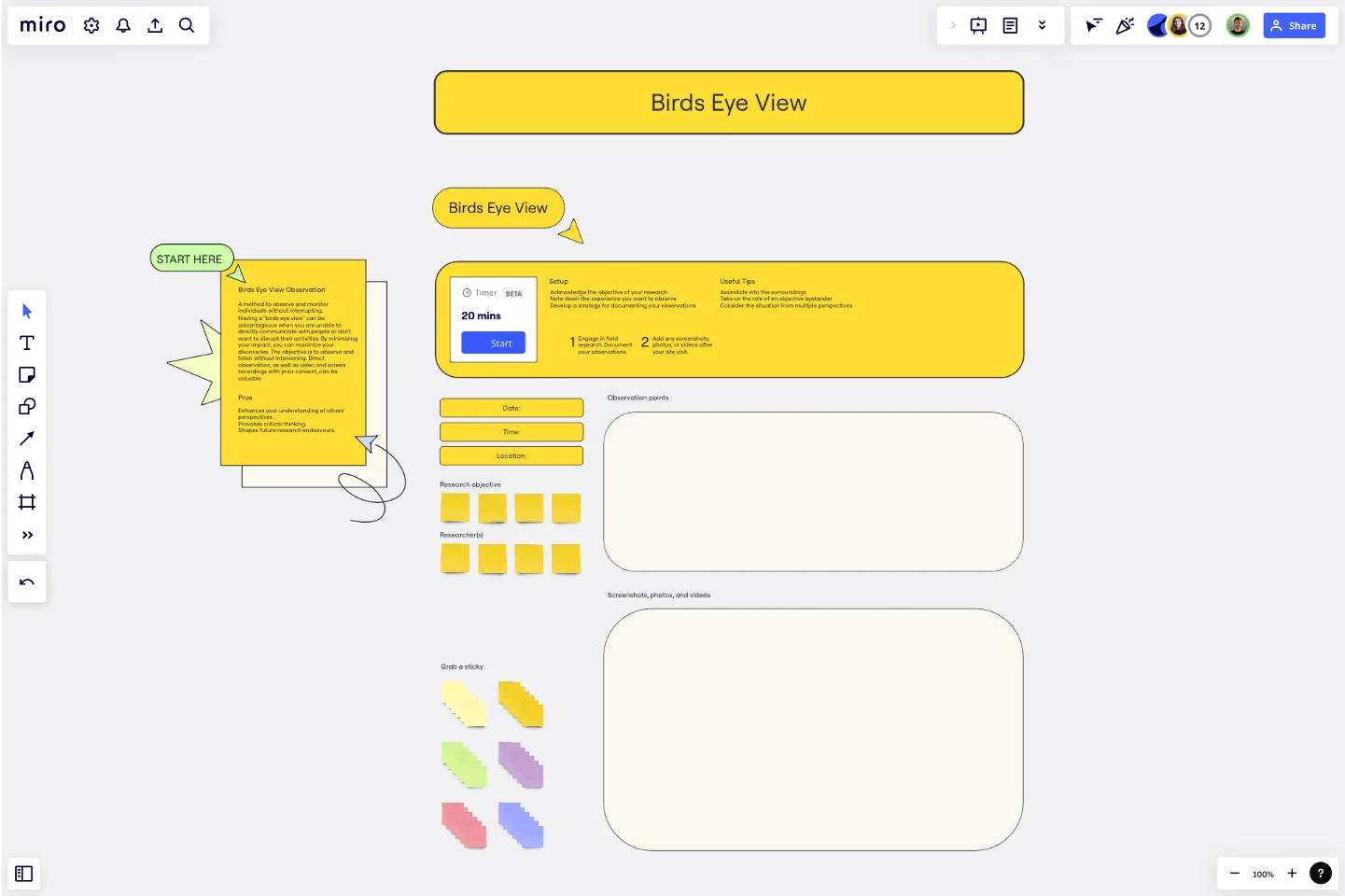Bird's Eye View Observation Template
View all the details without interrupting people with the Bird’s Eye View Template. It provides a comprehensive overview of everything that needs to be seen.
About the Bird’s Eye View Observation Template
Observe and monitor individuals without interrupting with the Bird’s Eye View Template. Having a "bird’s eye view" can be advantageous when you are unable to directly communicate with people or don't want to disrupt their activities. By minimizing your impact, you can maximize your discoveries.
The objective is to observe and listen without intervening. Direct observation, as well as video and screen recordings with prior consent, can be valuable.
Benefits of using the Bird’s Eye View Template
Enhances your understanding of others' perspectives.
Provokes critical thinking.
Shapes future research endeavors.
How to use the template in Miro
Engage in field research. Document your observations.
Add any screenshots or videos after your site visit.
Setup
Acknowledge the objective of your research.
Note down the experience you want to observe.
Develop a strategy for documenting your observations.
Useful tips
Assimilate into the surroundings.
Take on the role of an objective bystander.
Consider the situation from multiple perspectives.
Get started with this template right now.
In-Context Interviews Template
Works best for:
UX , Design, Design Thinking
The In-Context Interview Template helps you observe individuals in their natural habitat and is an effective method to gain a deeper understanding of their behavior and experiences. To achieve this, it is important to observe both their words and actions. Conducting an interview in their natural environment allows for real-time exploration of their experiences. While remote and online interviews are possible, synchronous engagement is preferred as it yields better results. The objective of this approach is to fully immerse oneself in the world of those who possess extensive knowledge about the subject being studied, thereby preventing the formation of inaccurate assumptions. Overall, using the in-context approach provides several benefits for gaining a more accurate understanding of individuals and their experiences.
Buy a Feature Template
Works best for:
UX, Design, Product
The Buy a Feature Template reveals the actual significance people attach to certain aspects, creating tension by presenting options that exceed available resources. The resulting decisions provide valuable insights into which features, concepts or initiatives should be prioritized in the future.
Empathy Map Pro
Works best for:
Market Research, Research & Design
Empathy Map Pro helps you dive deeper into understanding your users. By exploring their thoughts, feelings, and experiences, you can create more effective solutions tailored to their needs. This advanced template is perfect for product development teams aiming to enhance user satisfaction and drive innovation.
Service Blueprinting Workshop
Works best for:
Agile
The Service Blueprinting Workshop template helps teams visualize and improve service processes. It includes ice breakers, context canvas, empathy maps, and action plans for service transitions. Use it to align teams, identify opportunities, and prototype service delivery from a macro to microscopic level, ensuring a comprehensive understanding of service orchestration and seamless collaboration. Ideal for remote and dispersed teams.
Niching Down: Online Course Persona Empathy Map
Works best for:
Market Research, Research & Design
Niching Down Online Course Persona Empathy Map helps you tailor online courses to specific personas. By understanding their needs and motivations, you can design more effective and engaging course content. Perfect for course developers and educators.
Empathy Mapping by ServiceNow
Works best for:
Research & Design, Market Research
The Empathy Mapping template helps teams capture detailed user insights. By understanding user perspectives, you can improve product features and customer satisfaction. This template is perfect for user research and product development.
